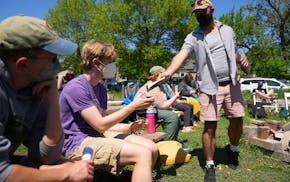DAHLGREN TOWNSHIP, Minn. — A cluster of trees about a half mile from the nearest county road concealed the plot of earth that drew FBI agents and Carver County investigators here in search of a body.
Fanning out in two rows, they eased rods into the ground to test for changes in soil composition before a patchwork of young weeds and dark dirt soon gave the burial site away.
"Most important thing, guys: Keep it all even," an FBI instructor coached, as one group already on its hands and knees methodically peeled back small layers of earth to avoid damaging any evidence beneath them.
A piece of clothing and a leg, uncovered five hours later, confirmed their tip and betrayed the location of the body: This was indeed where the pig had been laid to rest.
For three years, an FBI special agent who leads a specialized team to uncover remains and other evidence in Minnesota and the Dakotas has conspired with a local farmer to hide pig carcasses around the metro — all in the name of training police agencies on the techniques and care demanded when trying to pull answers out of the ground.
"Nobody wants to get in there, but it is a bit of a learning point," Special Agent Lizabeth Lehrkamp said one afternoon last month, standing feet away from where the first odorous traces of death began wafting out of the ground. "I don't do gross stuff without reason."
The "Pig Dig," as it's called, started as a joke and has since grown into an annual exercise led by the FBI's Evidence Response Team. Lehrkamp, its leader, buries a pig 18 months earlier within the jurisdiction of the agency the FBI will train.
Anoka and Ramsey counties participated before Carver this year, and the 2025 pig is already in the ground in another south metro county. For the first time, this year's dig had a theme – "The Pig Lebowski" — replete with matching pink T-shirts and, as they'd dig up later, corresponding "missing" posters and lanyards buried around the decedent.
The annual Pig Dig is among a series of trainings Lehrkamp's team offers local law enforcement in the three-state region the FBI Minneapolis division covers. She likes to use these sessions as outreach opportunities, freely sharing her contact information for future real-world collaborations. More importantly, she said, local investigators are most likely to be first on the scene.
"I'm trying to remind folks that all we want to do is collect evidence," Lehrkamp said. "If you get down and you dig up a pig with my folks, you're not gonna have a problem working with them at anytime in the future."
This training borrows concepts from courses elsewhere that deploy the real thing: donated human remains. Lehrkamp, like members of FBI evidence response teams nationwide, has trained at the famed "body farm" in Tennessee. Known formally as the Forensic Anthropology Center at the University of Tennessee in Knoxville, federal agents have trained at the site for more than 20 years. New programs have since sprung up in other climates, including in northern Michigan.
Though unable to bury human remains to train local investigators, Lehrkamp's use of a pig is the next closest tool available to test law enforcement on how to find a clandestine grave and sift through the dirt for evidence.
"What we want to make sure of is that they approach this type of crime scene with the same systematic methodology that they would other crime scenes," said Dawnie Wolfe Steadman, director of the Forensic Anthropology Center at the University of Tennessee-Knoxville.
When that crime scene is an outdoor burial, Steadman said, it's often not easy to determine "what all the evidence is — or even where it is."
A cigarette butt on the ground could be a relic from a neighbor's long-discarded garbage. Or it could possess traces of DNA capable of cracking a case that had long gone cold. Investigators are taught to discern between human and nonhuman remains and, importantly, how to preserve it in a way that can be presented in court.
Taking it slowly
Across two days last month, and after a day spent in a classroom, Carver County Sheriff's Office staff and two death investigators from the Midwest Medical Examiners Office worked alongside FBI agents to skim the suspected grave one small level at a time.
"This is something you don't just rush into," Sheriff's Lt. Brian Sloat later said. Sloat said the training helped dispel assumptions that stabbing a shovel into the ground until you struck something was good enough.
Law enforcement from Sloat's office and two death investigators from the Midwest Medical Examiners Office worked alongside FBI agents for the training. They filled orange Home Depot buckets with dirt to be fed through large hand-operated sifters. Piles of fine, almost flourlike soil accumulated nearby while the occasional shout alerted the group to a discovery.
Among the items found was an old, 3-inch square nail found at a recent previous burial site in Annandale. An excavator who'd been hired to help with a retaining wall project saw a human skull tumble out of a dirt pile. The nail helped date the remains to the late 1700s to early 1800s, likely connected to a family connected to the property for many generations.
Briefly at the time, Lehrkamp had hoped that the discovery would be the cold case crack that she's still longing to be a capstone to her soon-to-conclude FBI career.
"That's the cool stuff we're supposed to do — finding answers for families," said Lehrkamp, who started her tenure investigating organized crime in New Jersey.
The nearly 20-year veteran is propelled by a boundless energy and enthusiasm that she tries to extend to her team of about 40 investigators — right down to stocking team vans with fruit snacks and sports drinks to power them through marathon dig sessions in remote locations.
During the Carver County dig, little orange flags dotted a rectangular perimeter around the focus of the group's efforts. Each time they hit a piece of evidence — a cellphone case, headphones, a novelty straw or plastic spider ring — work slowed to a crawl. They scraped around each piece of evidence in a process called "pedestaling," and measured its location and depth.
Another teammate sketched each piece of evidence and its dimensions off to the side. That sketchbook, measurements and hundreds of photographs could be used to recreate the precise locations where each item was found with respect to the body and help determine how a victim met their end.
"I wonder if we're going to smell this thing before we see it," one of the investigators said, as the group uncovered fragments of the natural topsoil.
Someone else noted that the floor of the pit felt softer, signaling time to get out of the hole. Diggers donned white Tyvek suits and resumed their work while on their bellies and with their heads and arms draped into the hole.
By the end of the first afternoon outside, the team uncovered an outline of the pig and found the natural floor of the gravesite around it as vultures circled overhead.
Smelling death
The stench greeted the class as soon as they resumed digging on the second morning.
"Oh yeah, that smells awful. Anyone have Vicks?" one person said, referring to the pungent over-the-counter ointment. Another described how they preferred to spray air freshener on a facemask to "take the edge off" while approaching challenging death scenes.
"It's down to just the detail work now," Lehrkamp told the group. "Pedestal out and get dimensions."
This pig's organs were removed ahead of time, unlike previous specimens, so it at least would not smell as strongly. Judging by past Pig Digs, Lehrkamp expected the body to be compressed by the pressure of the local soil into what she's come to call "pig panini."
They reached for spoons and dustpans to further free the body from the ground. One instructor noted that the pig's legs were largely skeletonized and that last year's specimen came out of the hole in various chunks. One of the Midwest Medical Examiners death investigators participating in the class soon broke off each of the legs before placing them into brown paper evidence bags.
"This is why this process is important to get documented as it is found, because once you get it to the office it's a hot mess in the body bag," the instructor said.
Shane Sheets, director of the Midwest Medical Examiner's Office, which works with the FBI on death investigations in Indian Country, said that sending his staff to the annual Pig Dig helps them learn from mistakes, find out what works and understand each agency's role when they encounter a body.
"This Pig Dig in person is literally the closest that we can get at this time for a real clandestine grave or real-world body recovery incident," Sheets said.
The smell of decay hung in the air as the pig was guided into a black body bag before noon on the dig's final day. Investigators made sure to take a final measurement of the deepest part of the hole, something that could lend clues as to how the body was buried.
The packed-up pig would soon be off to one last burial spot for a much smaller training exercise in the fall. But first, Lehrkamp was waiting up a nearby hill with lunch prepared for the crew. It was pulled pork.

Want to share info with the Star Tribune? How to do it securely

'Safe recovery sites' would offer syringes, naloxone and more to people using drugs. The plan could be in peril.
New Minnesota GOP leaders seek peace with party's anti-establishment wing

Who is Republican Lisa Demuth, Minnesota's first House speaker of color?





